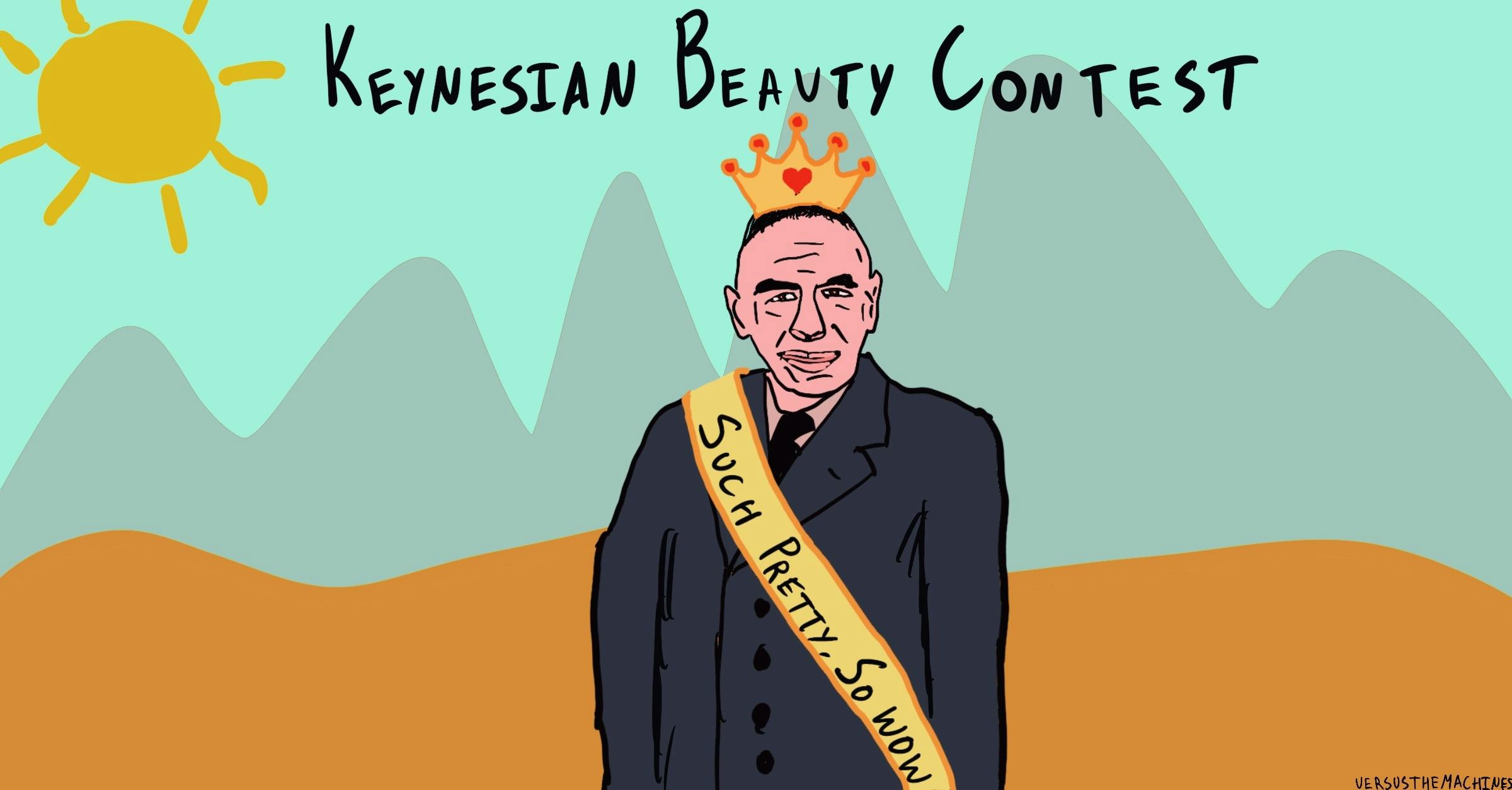The Keynesian Beauty Contest
The Basic Idea
How do you define beauty? You probably have a bevy of individual preferences. If asked, you could likely even give reasons about why you find certain things beautiful. However, if you have ever shared your opinions with other people, you might have realized that your standards of beauty are not universal: one person’s “beautiful” is another person’s “ugly.” Oftentimes, this diversity of preference is a good thing. In the dating world, our diversity of preferences enables everyone to find a partner– it would be pretty difficult if we were all vying for the same few people. But while our varied individual preferences may be useful in finding us a date, they are fueled by an irrational logic that can cause problems elsewhere.
The Keynesian Beauty Contest is an early theory in behavioral finance that describes how our perceptions of value can cause irrational fluctuations in supposedly rational systems. More specifically, it describes how short-term stock market fluctuations are not caused by changes in underlying value, but instead by investors attempting to figure out what others think the “average investor” finds valuable. According to this theory, attempting to time market changes is like trying to guess what your friend’s next partner will look like–you make guesses based on what you think they find “beautiful.” And in the same way we often fail to correctly guess our friends’ preferences, the Keynesian Beauty Contest shows that when we try to predict what others find valuable, we often get it wrong.

Successful investing is anticipating the anticipations of others.
– John Meynard Keynes, British Economist
Theory, meet practice
TDL is an applied research consultancy. In our work, we leverage the insights of diverse fields—from psychology and economics to machine learning and behavioral data science—to sculpt targeted solutions to nuanced problems.
Key Terms
Bounded Rationality: The concept that human rationality is limited by our cognitive abilities, information, and time. This is in contrast to the assumptions of mainstream economics, which view humans as perfectly rational beings.
Herd Behaviour:The mass mobilization of individuals collectively decided to follow each other. Often this occurs without any specific direction or leader and manifests itself in irrational behavior.
History
In the 1930’s, a popular newspaper game had people guess the prettiest face out of 100 photographs. Readers selected six faces each, and their choices would be compared to all other players’ submissions. If a player’s choices included the most popular face in the pool, they would win a prize.
One morning, famed British economist John Meynard Keynes read about this game in his local newspaper. Up until this point, Keynes, while a brilliant macroeconomist, struggled immensely in the stock market. He would try to predict when financial markets would change based on macroeconomic policies he expected to change; but despite knowing more about economics than most of Britain, he still only managed to collect average returns.
Due to his failure to reliably predict the market, Keynes was beginning to wonder if doing so was even possible. He, therefore, became interested in finding a model that explained what created rapid stock market bubbles, crashes, and other rapid price fluctuations, despite fundamental value not changing much from the day-to-day. The beauty contest game caught his eye as a potential model, and he proceeded to write about it in his 1936 work The General Theory of Employment, Interest and Money.
According to Keynes, you can use multiple different strategies when playing the beauty contest game. First, you could simply pick the six faces that you personally find most attractive. Keynes and other economists call this a “naive strategy,” as it is based on the assumption that your preferences are universal. Another strategy involves basing your decision on what you believe other players will find attractive. This is slightly more rational, however, it operates under the assumption that everybody else is using the naive strategy.
But what if everybody else used this more sophisticated strategy, and tried to guess what others find attractive? Well, then it gets complicated. You not only have to guess what other people find attractive; you also have to guess other people’s guesses, too. But once we’ve adopted this strategy, we end up in an infinite loop. To get ahead, each player needs to go one level deeper than everybody else: they need to guess other people’s preferences, and other people’s guesses, and other people’s guesses about other people’s guesses; and so on. While there could be an eventual winner, a simple game of deciding which faces are more beautiful becomes an intricate, infinite guessing game.
Keynes likened this form of strategic thinking to the stock market. To make quick money speculating in the stock market, you must buy before everybody else buys and sell before everybody else sells. By doing this, you can ride waves of investor confidence and get out before it inevitably tumbles. Therefore, if you can find out what the majority of players in the stock market were thinking, you can beat them. However, Keynes warns, we typically try to do this using the same flawed, infinite reasoning that we see in the beauty contest. We try to guess what other investors will buy and sell, and what other investors will guess about other investors, and what other investors will guess about other investors; and so on, forever. While it is possible to win big if you guess everything correctly, you are much more likely to lose. Guessing an infinite number of times all but guarantees that you’ll guess wrong at least once.
People
John Meynard Keynes
Perhaps one of the most influential economists of the modern era, John Meynard Keynes pioneered many of the current approaches in modern macroeconomics. In his seminal workThe General Theory of Employment, Interest and Money,Keynes outlined how government stimulus programs could be used to pull countries out of economic recession, which has since become a key tool in handling crises. Furthermore, he was a highly successful investor who studied and wrote about how financial markets operate.
Consequences
While not widely utilized today, the Keynesian beauty contest arguably set the stage for various concepts in behavioral economics to emerge. While Keynes used the system to analyze the stock market, what the model truly revealed is that humans aren’t perfectly rational. Sure, it’s possible to reason your way to the “correct” answer in the beauty contest, but victory is still not guaranteed. Often, we spend some time reasoning rationally, but then give up and resort to heuristics. This idea of a “bounded rationality” is what makes the beauty contest so difficult to win, as we all reason differently based on our available resources. Today, the psychological approach Keynes pioneered can also provide many intriguing insights into current oddities in the stock market today.
First, it is important to understand what the implications of people’s compounding perceptions can be. Given that investors are basing their decisions on the perceptions of others, bubbles can emerge which detach stock prices from their actual value. For example, if you believe that others are about to pile on a stock, it would make sense to buy that stock now, ride the wave up, and sell the stock off at a higher price to a more enthusiastic investor. Unfortunately, nowhere in this logic does it matter if you find that investment valuable or not, or if the investment is in fact valuable at all.
Furthermore, it is likely that everybody else is thinking about this investment the same way you are. This can lead to a self-fulfilling prophecy: investors pile onto a stock expecting to be able to sell it to somebody who values it more than them, while not taking into account that everybody in the market is doing the same thing. While everybody sees the stock spiking in the short term and feels like they are getting rich, the bubble eventually pops. This typically occurs when speculators’ confidence is shaken and they run out of other speculators to sell to. Since few actually value the stock as a long-term asset, speculators run out of buyers, and the stock crashes. We have seen many of these speculative asset bubbles like this in recent years, such as in cryptocurrency investing, Tesla stock, and the housing market.
So, how do you beat the market? After Keynes’ early stock market struggles, he shifted his focus away from attempting to make money fast by timing market trends. Given that short-term prices are driven by expectations from irrational actors about how other irrational actors will act, Keynes deemed trying to time these spikes as futile. Instead, he discovered something else that would later become another dominant paradigm: value investing. Embracing uncertainty, he looked for stocks were overly pessimistic attitudes made stocks prices fall below their inherent value, and sell when those attitudes dissipate and the stock’s price rises After doing this, Keynes became a prolific investor, consistently outperforming the market. In essence, he pioneered the approach Warren Buffet would later famously summarize as: “be fearful when others are greedy, and be greedy when others are fearful”.
Controversies
While it is an intriguing method of analyzing stock market bubbles and fluctuations, the Keynesian beauty contest model struggles to accurately explain how people’s irrational perceptions can actually change a company’s real value. One clear example is Amazon, which struggled heavily in its early years with poor profitability and shaky fundamentals. Despite this, their stock soared. In essence, early Amazon investors were basing their decisions on nothing but the perceived value of Amazon becoming the mammoth that it is today. If you were taking the advice of value investors like Buffet and Keynes, you would have avoided this investment for a few years, as it would be overvalued compared to its fundamentals. Despite this, knowing what we know now, you would probably invest in Amazon in a heartbeat if given the chance to go back in time. Why is this the case?
An alternative theory that can explain Amazon’s dominance-despite-irrationality is the theory of reflexivity. A method built upon the premises of the Keynesian beauty contest, reflexivity has been popularized in recent years by American billionaire hedge-fund manager George Soros. This model states that there are feedback loops between investors’ perceptions of reality and the underlying fundamentals of an asset. Put simply, if you believe that others will invest in Amazon stock and increase its price, this can initiate a positive feedback loop which actually makes Amazon more valuable. This is because investor cash can buy a company the vital time, assets, and opportunities it needs to fix its underlying issues. For Amazon, this was their development of Amazon Web Services, which has been the key engine of their profitability to this day.
While reflexivity, as a study of irrational prices, may sound similar to Keynes’ model, it is actually a critique of it. Soros himself has stated that behavioral economics is only valuable for understanding how perceptions alter prices, while it completely avoids how perceptions can change a stock’s actual value. While it has yet to gain mainstream acceptance, reflexivity may infuse a much-needed update to behavioral economics concepts like the Keynesian beauty contest.
Case Study
The Keynesian Cuteness Podcast:
In 2011, NPR’s Planet Money podcast did an episode where they tested the Keynesian model of rational decision-making by having its listeners select the cutest animal out of three adorable videos. Collaborating with Professor Pietra Rivoli of Georgetown, the podcast split up its 12,000 participants into two groups who would both be making decisions about who was the cutest critter. The first group was simply asked to pick which animal they thought was the cutest; the second group picked the animal that they believed everyone else would pick as the cutest.
The experiment had some dramatic results. Between a kitten, a baby slow loris, and a baby polar bear, half of the first group decided that they found the kitten was the cutest. The second group’s decision was more dramatic– 76% chose the kitten. The podcast talked to one listener named Marla, who was assigned to the second group to understand this disparity. While she found the slow loris the cutest, she picked the kitten instead, as she believed everybody else would pick it too. The podcast emphasized that if the stock market was full of individuals like Marla, there could be a “kitten bubble”, even if nobody actually thought kittens were the cutest.
Related TDL Content
The Unconscious Process Behind Financial Instability: In this piece, TDL associate Nathan Collett talks with Professor Selim Aren, a professor of business administration at Yildiz Technical University, about how our unconscious processes contribute to market instability. Outlining his theory of “phantasy,” the two dive deep into an alternative way of describing the phenomena underlying economic bubbles.
Robert Shiller: If you are looking for more modern takes on behavioral finance, speculative bubbles, and market crashes, look no further than TDL’s article on Robert Shiller. A Nobel prize-winning economist and author of Irrational Exuberance, Shiller’s work has come to revolutionize how we examine economic phenomena through a behavioral lens.
Sources
- Keynes, John Maynard, 1883-1946. (1936). The general theory of employment, interest and money. London :Macmillan,
- See 1.
- Rich, B. (2021, May 18). Bitcoin, Tesla, Lumber: Bubbles Bursting? Forbes. https://www.forbes.com/sites/bryanrich/2021/05/18/bitcoin-tesla-lumber–bubbles-bursting/?sh=34fc15ba760e.
- Hofmann, J. (2021, July 1). Keynes the value investor. Investors’ Chronicle. https://www.investorschronicle.co.uk/news/2021/07/01/keynes-the-value-investor/.
- Brownlee, A. P. (2021, May 19). Warren Buffett: Be Fearful When Others Are Greedy. Investopedia. https://www.investopedia.com/articles/investing/012116/warren-buffett-be-fearful-when-others-are-greedy.asp.
- Kim, T. (2018, May 7). Warren Buffett: I was wrong on Google and Amazon, Jeff Bezos achieved a business ‘miracle’. CNBC. https://www.cnbc.com/2018/05/05/buffett-i-was-wrong-on-google-and-amazon-bezos-achieved-a-business-miracle.html.
- The Investopedia Team. (2021, June 9). Reflexivity Definition. Investopedia. https://www.investopedia.com/terms/r/reflexivity.asp.
- Motley Fool Staff. (2019, February 19). How Amazon Actually Makes Money. The Motley Fool. https://www.fool.com/investing/2019/02/19/how-amazon-actually-makes-money.aspx.
- Kestenbaum, D. (2011, January 14). Ranking Cute Animals: A Stock Market Experiment. NPR. https://www.npr.org/sections/money/2011/01/14/132906135/ranking-cute-animals-a-stock-market-experiment.


